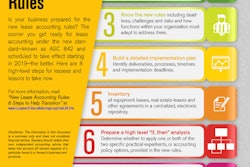
Revenue recognition has always represented a challenge for the construction sector. This basic accounting principle defines the how and when a business addresses income it earns through contracted work. Since much of construction takes place incrementally, with payments often far removed from the time an initial contract is signed, determining the appropriate date to use for the company’s financial accounting can be tricky.
In May of 2014, the FASB in partnership with the International Accounting Standards Board released a much-anticipated update to GAAP standards for this complex area. Accounting Standards Update (ASU) 2014-09, Revenue from Contracts with Customers (Topic 606), as the guidance is titled, makes sweeping changes to revenue recognition in accounting and related reporting. As a result, contractors can expect their revenue recognition to vary dramatically in amount and timing from current patterns.
In a series of updates since ASU 2014-09 was first issued, FASB has amended the guidance further. Topic 606 can now be considered final (to the degree any GAAP standards are truly final). For most construction companies, the December 31, 2019, financial statement was the first one for required adoption.
Read next: Lease Accounting Changes: Make Sure Three Strikes Doesn’t Mean You’re Out
FASB’s core principle in the updated standard was ensuring that entities “recognize revenue to depict the transfer of promised goods or services to customers in an amount that reflects the consideration to which the entity expects to be entitled in exchange for those goods or services.” To that end, the guidance creates a five-step process for determining the appropriate time to recognize revenue:
- Identify the contract
- Identify the performance obligations contained in the contract
- Determine the transaction price
- Allocate the transaction price to the performance obligations in the contract
- Recognize revenue as each performance obligation is met or satisfied
Topic 606 details a great many tests and rules for implementing each of the five steps, too comprehensive for treatment in this article. There are a number of important concepts, though, that construction professionals should bear in mind as they begin delving into a serious study of the revised regulations.
Key considerations of revenue recognition updates
Despite the detailed nature of the guidance, applying the five-step process it outlines will demand some amount of estimation. In addition, company representatives should be prepared to make reasonable interpretations and judgement calls based on the intent of the standard and the terms of a particular contract.
Read next: 6 Areas New Technology Can Help Construction Finance Professionals
Whereas older guidance offered contractors a choice between percentage of completion or completed contract accounting methods, the new standard applies specific criteria that govern which method they should utilize. Some methods of measuring relative completion status when recognizing contract revenue over time may render the cost-to-cost method unsuitable.
If the results will be essentially the same, it is acceptable for contractors to apply ASC 606 to a portfolio of contracts rather than individually accounting for each. Companies should be able to provide documentation supporting the assumption that the portfolio approach will not lead to materially different results when electing this option. Estimates and judgments used in applying the portfolio method must be appropriate for the nature and total amount of revenue in the portfolio.
To help users more readily understand the contents of financial statements, contractors are required under ASC 606 to make additional disclosures, both quantitative and qualitative. FASB says about its new disclosure standard:
An entity should disclose sufficient information to enable users of financial statements to understand the nature, amount, timing and uncertainty of revenue and cash flow arising from contracts with customers. Qualitative and quantitative information is required about:
- Contracts with customers — including revenue and impairments recognized, disaggregation of revenue, and information about contract balances and performance obligations (including the transaction price allocated to the remaining performance obligations)
- Significant judgements and changes in judgements — determining the timing of satisfaction of performance obligations (over time or at a point in time), and determining the transaction price and amounts allocated to performance obligations
- Assets recognized from the costs to obtain or fulfill a contract.
For many contractors, the new disclosure requirements will necessitate changes to internal systems and processes. Balance sheet presentation of contract assets and liabilities will demand complex analysis as well in order to provide adequate transparency. Company leaders should not underestimate the difficulty and time needed for meeting new disclosure and balance sheet requirements; to remain in compliance, entities must undertake a serious effort and have professional advisors familiar with the new rules..
Other important considerations
- ASC 606 does not apply to certain types of contracts that include leases; insurance contracts covered under ASC 944; guarantees other than those tied to product or service warranties; and some non-financial exchanges.
- Some types of obligations and contractual rights are similarly excluded.
- Non-financial transfers between contractors and non-customers may in some circumstances merit the same treatment as that described in ASC 606 guidance for customer contracts.
Contractors must start complying now
Given the scope of the changes, a sense of urgency in regard to understanding and transitioning to the new regulations is fully warranted. Companies that haven’t yet addressed the issue are likely to discover multiple questions as they begin the process of adapting to ASU 2014-09, some of which may be answered in the FASB’s Topical Reference Guide.
However, we urge all organizations impacted by the updated revenue recognition standards to seek qualified professional help in interpreting and applying the regulations.
Ryan Inlow, Certified Public Accountant, specializes in audit and tax services for closely-held entities, non-profit organizations and employee benefit plans. Inlow has a wide variety of industry experience with current and former clients in the technology, manufacturing, agriculture and construction industries. Inlow serves as the Partner In Charge of Mauldin & Jenkins' Albany Office, Chair of the firm’s Executive Committee, and as the Practice Leader for the Entrepreneurial Services practice firm-wide.
















